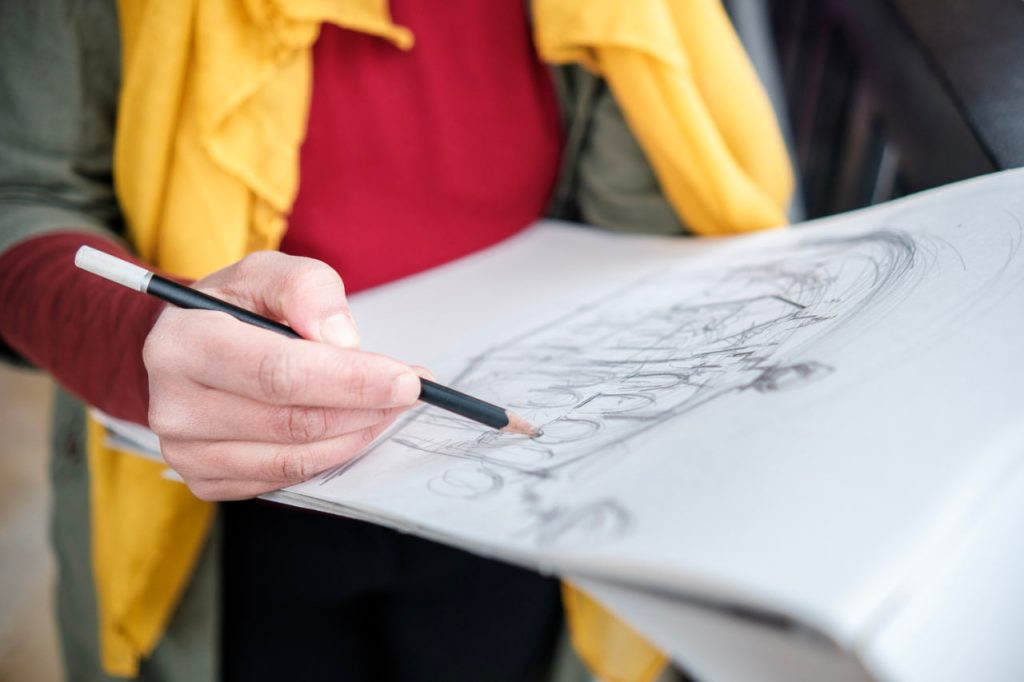Drawing What You Think, Not What You See
One of the most common mistakes beginners make is drawing from memory or assumption instead of observation. People often draw what they think a hand, eye, or chair looks like, rather than carefully studying the object in front of them. This leads to flattened forms, incorrect proportions, and stiff drawings.
To fix this, spend time drawing from life. Use still life objects, mirrors, or reference photos. Train your eye to measure angles, negative space, and relationships between parts. The more you observe, the more accurately you’ll draw.
Avoiding Construction and Structure
Many beginners jump straight into outlining their subject without thinking about underlying structure. This results in drawings that look unstable or lack volume. They may draw the contour of a face but forget the skull beneath it. They might sketch a figure’s outline without understanding the balance or gesture of the pose.
The solution is to use construction methods. Start with simple 3D forms like spheres, cylinders, and boxes. Use these to build up the body, head, and other complex objects. It may feel technical at first, but it’s the fastest path to solid, believable drawings.
Over-Reliance on Outlines
Beginners often rely heavily on outlines to define everything. While outlines are useful, real objects are not made of lines. They are defined by light, shadow, and form. When outlines are used excessively, drawings can appear flat and cartoonish, even when realism is the goal.
Instead, focus on shading and values to describe form. Practice drawing using only tonal relationships — no lines — to train your eye to see edges, planes, and volume through light rather than contours.
Neglecting Proportion
A classic beginner issue is skewed or inconsistent proportion. The head may be too large for the body, the eyes too close together, or the limbs too long. This happens when artists draw individual parts without comparing them to one another.
Fixing proportion starts with learning basic measurements and relationships. Use reference points, guidelines, and comparative measurements. Ask questions as you draw: How many eye-widths across is the face? Where does the hand fall in relation to the knee? Constantly compare and adjust.
Drawing Without Planning
Jumping into a drawing without any planning can lead to poor composition, awkward spacing, or running out of room on the page. Beginners often start at one point and work their way out without thinking about the overall structure.
To avoid this, begin with a light gesture or thumbnail sketch to map out the entire subject. Block in big shapes and placements before refining details. Planning helps keep your drawing balanced and avoids frustration halfway through.
Fear of Making Mistakes
Many beginners hesitate to put down marks, constantly erase, or stop midway because they feel it’s “not good enough.” This perfectionism stunts growth. Fear of failure prevents experimentation, and without risk, there’s no real learning.
The fix is to embrace drawing as a process. Give yourself permission to make bad drawings — they are stepping stones to better ones. Use a sketchbook for messy experiments. Draw fast, draw loose, and focus on improvement, not perfection.
Lack of Consistency
Drawing once a week or only when inspiration strikes can lead to slow progress. Many beginners expect rapid improvement without regular practice, but drawing is a skill that develops with time and repetition.
Create a consistent schedule. Even 20–30 minutes a day can lead to massive progress over weeks and months. Use exercises, challenges, or timed studies to stay engaged. The key is consistency, not intensity.
Ignoring Light and Shadow
Shading is often an afterthought for beginners. They may add random shadows without understanding the light source, or they may fill in areas flatly without considering value hierarchy. This causes drawings to look muddy or lifeless.
To improve, study light behavior. Practice with single light sources. Learn how light wraps around form, how shadows fall, and where highlights occur. Try drawing simple objects — spheres, cubes, cones — and focus only on value. This will make a huge difference in realism.
Rushing the Process
It’s common to want results quickly. Beginners may race through a sketch, skip observation, or move to detail before the foundations are right. The result is frustration and disappointment.
The solution is patience. Take your time to build a drawing in stages. Focus on gesture, then structure, then refinement, and finally detail. Each phase builds upon the last. Learn to enjoy the process instead of just the outcome.
Not Seeking Feedback
Finally, many beginners draw in isolation and never seek critique. While drawing alone is useful, feedback can dramatically speed up your learning. It reveals blind spots, offers new techniques, and encourages growth.
Find mentors, join drawing groups, or take classes. Share your work and ask specific questions. Even one good critique can shift your perspective and help you improve faster than hours of solo effort.

